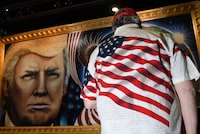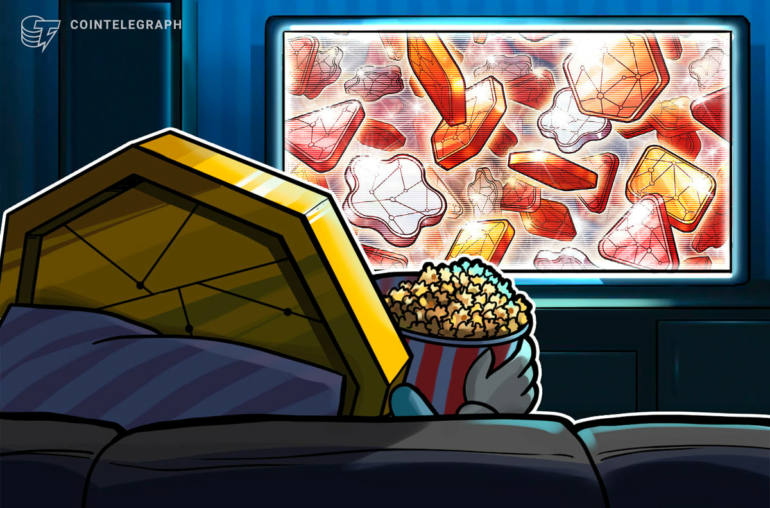Sign in
Perhaps the most useful and honest image from the new website advertising Donald Trump’s digital trading cards is at the bottom of the page, where Trump gives two thumbs up while winking at the viewer. The twofold message seems simple: Everything is A-OK, and this is all a bit of a joke.
People certainly laughed heartily on Thursday when Trump made what he had billed as a “Major Announcement.” He was now offering for sale “limited edition” digital trading cards, featuring what appeared to be risibly amateurish images of the former president playing golf, posing as an astronaut, surrounded by bars of gold and shooting lasers from his eyes.
This latest entrepreneurial endeavor from a businessman with myriad failures and bankruptcies seems to be a belated effort to cash in on the market for “non-fungible tokens.” NFTS include the sale of images given a unique digital stamp and thus, theoretically, an artificial scarcity. NFTS use bitcoin technology and can be bought and sold like any other commodity. The market for them may have peaked in 2021 with the $69 million sale of a digital collage by an artist called Beeple. Since then, the market has crashed.
Critics derided the crude iconography of the images and their clumsy construction. The “Collect Trump Cards” website attributes the designs to Clark Mitchell, an artist who specializes in popular imagery, saying, “He has prominent working relationships with brands such as Star Wars, Hasbro, Mattel, Marvel.” Mitchell has a basic mastery of the hypermasculine tropes of comic book culture and professional sports.
If the images seen on the website are similar to the digital images that will be transferred to anyone who pays the $99 fee, then the Trump cards will feature clumsy Photoshop pictures of the former president’s face grafted onto reasonably fit male bodies, clad in various costumes of masculine bravado, including sporting garb, a sheriff’s duster and lots of blue suits.
The Lincoln Project, a political action committee that specializes in slickly produced social media mockery of Trump, posted a clip of the online video announcement overlaid with canned laughter. “Stop. We can only laugh so much,” said the tweet, which had racked up more than 19,000 likes a day after the Major Announcement.
Stop. We can only laugh so much.
Trump's #MajorAnnouncement is a major flop. pic.twitter.com/aFitG9A2qf
Along with laughter, however, was the pervasive sense that this newest scheme has distilled the essence of Trump to its purest form. It was “on brand” in a way more telling and disturbing than previous efforts to cash in on a name once associated with the Oval Office.
We can look to some of the darker trends in the contemporary art market to sharpen that intuition. In his announcement, Trump wrote, “These limited edition cards feature amazing ART of my Life & Career!”
Art was prominently capitalized, sharpening the dissonance between a word that summons thoughts of Leonardo, Rembrandt and Picasso and the image that followed — Trump as superhero in tights and a cape. A similar dissonance is often felt in contemporary art museums and markets when seemingly trivial or worthless objects — garbage or things found on the street, random mementos plucked from the cupboard of memory — are repurposed as art and treated as both intellectually substantial and commercially valuable.
The shorthand critique of this phenomenon is: “My kid could do that.” And, indeed, your kid could probably make images of Trump as laughably awful as the ones that Trump is now attempting to sell, if your kid has even a passing familiarity with the tropes of pop culture and basic competence with photo-editing software.
In the art world, the conceptual move that rebrands supposed trash as art isn’t quite so simple. It has a long pedigree, dating back to the work of Marcel Duchamp, whose infamous “readymade” sculpture included a 1917 work known as “Fountain,” a urinal turned 90 degrees on its axis and signed with a cipher for the artist’s name. And, yes, your kid could probably reposition a urinal and sign his or her name to it, but they probably couldn’t do it at just the right historical moment to inaugurate a century of discussion about what constitutes art. Is it the material object or the idea? An original form or its iteration?
People laughed at Duchamp’s urinal, and they are laughing still at its descendants, which can be found in galleries and art markets around the world. This isn’t to argue that Trump’s ART is art. It isn’t. What matters here is how laughter defines community and how closely Trump’s attempt to market amateurish iconography parallels the way artists, critics and collectors have used laughter to establish the boundaries of the art world.
Simply put, if you can’t take Duchamp or conceptual art seriously, you are a philistine, by the definition of the art world. It proves that you are unwilling or incapable of a basic set of thought exercises and mental calisthenics that are essential to the appreciation of contemporary art. One of the hallmarks of Trump’s art, and the work of other artists who have attempted to market Trump imagery as art, is the expectation that elites will laugh at it. Those who laugh are immediately outsiders to Trump world, where a taste for the tawdry is established as a fundamental shibboleth of loyalty and belonging.
Call it inverse philistinism: the use of intentionally bad imagery, perhaps with a wink, to create an “us-them” dynamic. Other artists who align themselves with Trump have done this, as well. Jon McNaughton, who calls himself “America’s foremost conservative artist,” has created treacly depictions of Trump as a saintly figure nurturing a suffering America to rekindle its idealism and find its true soul. But he has also created a cartoonish image of Trump and his wife, Melania, riding in a giant, flag-emblazoned pickup truck, titled “Keep on Trumpin’,” a reference to a 1968 countercultural cartoon, “Keep on truckin’,” by artist Robert Crumb.
The text below the image (available as a signed canvas print for $399) makes the economy of inverse philistinism explicit: “YOU might be a TRUMP SUPPORTER if you think attaching US flags to a jacked up 4-wheeler is patriotic! … YOU might be a TRUMP SUPPORTER if you hang McNaughton Paintings in your house!” McNaughton also sells Trump NFTs, and Trump’s recent foray into that market is likely an attempt to muscle out competitors.
Another artist, Julian Raven, began an ultimately fruitless battle with the Smithsonian in 2017 after the National Portrait Gallery refused to hang his 16-foot-long painting of Trump’s head next to a soaring eagle and American flag, a portrait only marginally better than Trump’s trading cards. Raven’s challenge to an established museum was a public performance, designed in part to suggest that the Portrait Gallery’s standards of quality and inclusion were simply irrational, and if you believe in inverse philistinism, they are. Once “high art” expanded its boundaries to include “bad art” or things that were never intended to be art, the makers of bad art were empowered to challenge the institutional authority of the art world.
Strategically, of course, the best thing for the Trump brand, the best hope of sustaining his popularity, is to get people who are inclined to laugh at Trump to keep laughing at Trump. This fires the fury of his followers, who feel it is they who are being laughed at, and that in turn inspires the purely tribal sense of identification with the former president.
The joke, in the end, will unfortunately be at the expense of people who pay $99 for his NFTs, which, despite what appears to be an initial surge of interest, are likely to be extremely risky as a long-term investment. But that, too, is very on brand for Trump, a perfect distillation of his unique take on marketing. NFTS are a reductio ad absurdum of art: You aren’t paying for an object or a thing, just an idea or a feeling. Trump does the same for politics: When you invest in him (with your votes, your financial support or simply your affection), you get next to nothing tangible in terms of policy or accomplishments. But you do get to belong to his community, with all its intangible but non-fungible benefits.


